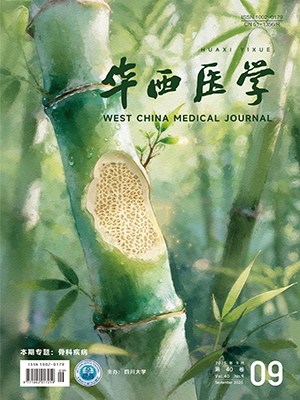| 1. |
Mehrotra R, Devuyst O, Davies SJ, et al. The current state of peritoneal dialysis. J Am Soc Nephrol, 2016, 27(11): 3238-3252.
|
| 2. |
Li PK, Chow KM, van de Luijtgaarden MW, et al. Changes in the worldwide epidemiology of peritoneal dialysis. Nat Rev Nephrol, 2017, 13(2): 90-103.
|
| 3. |
Kim H, Ryu DR. A prime determinant in selecting dialysis modality: peritoneal dialysis patient survival. Kidney Res Clin Pract, 2017, 36(1): 22-28.
|
| 4. |
Einbinder Y, Cohen-Hagai K, Shitrit P, et al. ISPD guideline-driven retraining, exit site care and decreased peritonitis: a single-center experience in Israel. Int Urol Nephrol, 2019, 51(4): 723-727.
|
| 5. |
van Diepen AT, Tomlinson GA, Jassal SV. The association between exit site infection and subsequent peritonitis among peritoneal dialysis patients. Clin J Am Soc Nephrol, 2012, 7(8): 1266-1271.
|
| 6. |
Li PK, Szeto CC, Piraino B, et al. ISPD peritonitis recommendations: 2016 update on prevention and treatment. Perit Dial Int, 2016, 36(5): 481-508.
|
| 7. |
Lloyd A, Tangri N, Shafer LA, et al. The risk of peritonitis after an exit site infection: a time-matched, case-control study. Nephrol Dial Transplant, 2013, 28(7): 1915-1921.
|
| 8. |
Szeto CC, Li PK, Johnson DW, et al. ISPD catheter-related infection recommendations: 2017 update. Perit Dial Int, 2017, 37(2): 141-154.
|
| 9. |
Rodríguez-Carmona A, Pérez-Fontán M, López-Mu?iz A, et al. Correlation between glycemic control and the incidence of peritoneal and catheter tunnel and exit-site infections in diabetic patients undergoing peritoneal dialysis. Perit Dial Int, 2014, 34(6): 618-626.
|
| 10. |
林建雄, 梁碧寧, 魯樹超, 等. 老年腹膜透析患者導管出口處感染的特點及危險因素分析. 中華腎臟病雜志, 2020, 36(6): 417-423.
|
| 11. |
曹竹如, 彭翠翠, 何淑雙, 等. 腹膜透析患者并發出口處感染及隧道炎的危險因素及護理對策. 臨床護理雜志, 2021, 20(2): 55-58.
|
| 12. |
Ding XR, Huang HE, Liao YM, et al. Daily self-care practices influence exit-site condition in patients having peritoneal dialysis: a multicenter cross-sectional survey. J Adv Nurs, 2021, 77(5): 2293-2306.
|
| 13. |
高永祥, 張晉昕. Logistic 回歸分析的樣本量確定. 循證醫學, 2018, 18(2): 122-124.
|
| 14. |
秦錦, 孫慶華, 蘇春燕, 等. 北京地區腹膜透析護士外出口護理和培訓實踐現狀調查. 中國血液凈化, 2019, 18(5): 345-348.
|
| 15. |
Prowant B, Schmidt L, Burrows L, et al. A tool for nursing evaluation of the peritoneal dialysis catheter exit site. ANNA J, 1987, 14(1): 28, 30.
|
| 16. |
Thodis E, Passadakis P, Ossareh S, et al. Peritoneal catheter exit-site infections: predisposing factors, prevention and treatment. Int J Artif Organs, 2003, 26(8): 698-714.
|
| 17. |
Cho KH, Jy DO, Park JW, et al. Catheter revision for the treatment of intractable exit site infection/tunnel infection in peritoneal dialysis patients: a single centre experience. Nephrology (Carlton), 2012, 17(8): 760-766.
|
| 18. |
Abud AC, Kusumota L, Dos SM, et al. Peritonitis and catheter exit-site infection in patients on peritoneal dialysis at home. Rev Lat Am Enfermagem, 2015, 23(5): 902-909.
|
| 19. |
Beckwith H, Clemenger M, Mcgrory J, et al. Repeat peritoneal dialysis exit-site infection: definition and outcomes. Perit Dial Int, 2019, 39(4): 344-349.
|
| 20. |
Holley JL, Bernardini J, Piraino B. Risk factors for tunnel infections in continuous peritoneal dialysis. Am J Kidney Dis, 1991, 18(3): 344-348.
|
| 21. |
Flanigan M, Gokal R. Peritoneal catheters and exit-site practices toward optimum peritoneal access: a review of current developments. Perit Dial Int, 2005, 25(2): 132-139.
|
| 22. |
Eklund B, Honkanen E, Kyll?nen L, et al. Peritoneal dialysis access: prospective randomized comparison of single-cuff and double-cuff straight Tenckhoff catheters. Nephrol Dial Transplant, 1997, 12(12): 2664-2666.
|
| 23. |
Lo WK, Lui SL, Li FK, et al. A prospective randomized study on three different peritoneal dialysis catheters. Perit Dial Int, 2003, 23(Suppl 2): S127-S131.
|
| 24. |
Meng C, Beco A, Oliveira A, et al. Peritoneal dialysis cuff-shaving: a salvage therapy for refractory exit-site infections. Perit Dial Int, 2019, 39(3): 276-281.
|
| 25. |
Hoekstra BP, de Vries-Hoogsteen A, Winkels B, et al. Exit site care in the Netherlands: the use of guidelines in practice. J Ren Care, 2017, 43(3): 156-162.
|
| 26. |
Figueiredo AE, Bernardini J, Bowes E, et al. A syllabus for teaching peritoneal dialysis to patients and caregivers. Perit Dial Int, 2016, 36(6): 592-605.
|
| 27. |
Iida H, Kurita N, Fujimoto S, et al. Association between keeping home records of catheter exit-site and incidence of peritoneal dialysis-related infections. Int Urol Nephrol, 2018, 50(4): 763-769.
|
| 28. |
Bernardini J, Price V, Figueiredo A, et al. Peritoneal dialysis patient training, 2006. Perit Dial Int, 2006, 26(6): 625-632.
|
| 29. |
Gadola L, Poggi C, Poggio M, et al. Using a multidisciplinary training program to reduce peritonitis in peritoneal dialysis patients. Perit Dial Int, 2013, 33(1): 38-45.
|
| 30. |
Chern YB, Ho PS, Kuo LC, et al. Lower education level is a major risk factor for peritonitis incidence in chronic peritoneal dialysis patients: a retrospective cohort study with 12-year follow-up. Perit Dial Int, 2013, 33(5): 552-558.
|
| 31. |
Chang JH, Oh J, Park SK, et al. Frequent patient retraining at home reduces the risks of peritoneal dialysis-related infections: a randomised study. Sci Rep, 2018, 8(1): 12919.
|
| 32. |
Gonthier D, Bernardini J, Holley JL, et al. Erythema: does it indicate infection in a peritoneal catheter exit site?. Adv Perit Dial, 1992, 8: 230-233.
|
| 33. |
于海霞, 許瑩, 蘇琦, 等. 腹膜透析新病人外出口感染原因及護理對策. 中華現代護理雜志, 2008, 14(26): 2789-2790.
|
| 34. |
Figueiredo AE, De Mattos C, Saraiva C, et al. Comparison between types of dressing following catheter insertion and early exit-site infection in peritoneal dialysis. J Clin Nurs, 2017, 26(21/22): 3658-3663.
|
| 35. |
Wong SS, Chu KH, Cheuk A, et al. Prophylaxis against Gram-positive organisms causing exit-site infection and peritonitis in continuous ambulatory peritoneal dialysis patients by applying mupirocin ointment at the catheter exit site. Perit Dial Int, 2003, 23(Suppl 2): S153-S158.
|




